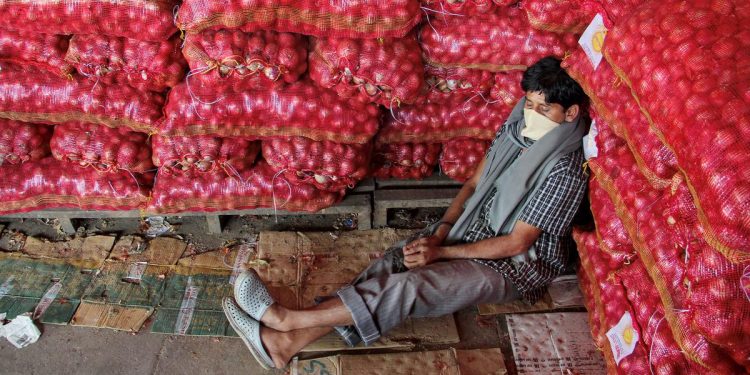Debashish Mitra
The government says it will double farmer incomes on one hand and on the other when it is required to make a choice between increasing farmer incomes and protecting the urban consumer, the decision favours the urban consumer at the cost of the farmer and rural India.
The recent decision of the government to ban onion exports, at a time when the country was professedly trying to strengthen exports, defies logic. We speak about improving relations with neighbours in South Asia, excluding Pakistan, but the ban particularly affects Bangladesh and Sri Lanka. The quantum of onions these countries need, would be a few thousand tonnes. We could have earned goodwill and forex by allowing onion exports to South Asia, and kept prices remunerative for farmers. The Bangladesh PM, too, raised the point recently. It is clearly not the way to build the much-needed goodwill in the neighbourhood.
Why does this happen repeatedly? Crocodile tears are shed when farm gate prices crash, be it onions, potatoes and tomatoes; statements are made about compensating the farmers, but nothing is seen. A niggardly Rs 500 crore was allocated two budgets ago, for a price stabilisation programme to create solutions to this issue. Rs 500 crore for three key vegetables that exist in every home, and whose annual production is in excess of 100 million tonnes — more than the country’s annual steel production. An estimated 10 million farmers grow these crops commercially, with a whole ancillary economy, including bag-making, crate-making, labour and transport associated with it, perhaps a multiplier effect of five. Steel, on the other hand, with its capital intensity, employs maybe a million people, which begs the question, whose interest does the government serve?
Recently there was talk of infrastructure investments — Rs 100 lakh crore was promised from the ramparts of the Red Fort, to make the targeted $5 trillion economy happen. It is for ‘modern’ infrastructure, such as the Rs 80,000 crore for the Bullet train from Mumbai to Ahmedabad, for roads and port and airports, digital highways, electricity and such like no doubt.
China and Japan collectively import more than $150-billion worth of food, and China alone imports $45 billion worth of soya beans. The beneficiaries of these imports are mainly Brazil and USA, which are thousands of miles away, at a time when we share a border with China and could easily grow soya beans for that country
Where is commitment to cold storages? A 10,000-tonne cold storage can be built using Rs 20 crore. Which means for Rs 10,000 crore we can as a country store more than 5 million tonnes of perishable produce, by building 500 such storages, at least one for each important fruit and vegetable growing district. Dedicate Rs 1,00,000 crore, and the figure becomes 50 million tonnes, we grow over 300 million tonnes of fruits and vegetables annually, crops that ruin small farmers when there is a glut, which happens every year, in one or the other crop. This investment, on a recurring basis, would benefit at least 10 million farmers and their families, and the associated industry, besides having significant impact on employment and industrial production.
But crocodiles don’t cry, even if harsh, it seems to be an appropriate metaphor to describe the attitude of urban India vis-a-vis rural India. It is only of interest as a consumption market, or to drive wealth creation in the stock market, which rises with every successful monsoon forecast. Even if a more recent popular metaphor of the ‘holy cow’ is taken, the cow needs to be looked after to produce milk. Are we really looking out for our farmers and ruralfolk? Or do we intend to just milk them dry, and convert them to urban migrants condemned to live in ghetto-like shanties, like the millions of abandoned milch cows now that roam the rural countryside?
The recent announcements by the finance minister on the benefits being given out to industry, and urban folk is staggering. Nothing of significance is there for the agriculture sector, which drives the country’s employment and income, and therefore consumption. All leading nations make use of their lands to fuel mainstream industries. Be it energy, building materials, or paper, besides, of course, the food industry. Do we look at our land bank the same way, or only as means to create urban-centric solutions?
China and Japan collectively import more than $150-billion worth of food, and China alone imports $45 billion worth of soya beans. The beneficiaries of these imports are mainly Brazil and USA, which are thousands of miles away, at a time when we share a border with China and could easily grow soya beans for that country. India on the other hand continues to import to stabilise urban prices, the most recent being maize, the hidden ingredient behind the now ubiquitous chicken biryani and tandoori chicken. Can we not have a focused plan to export different food products to these countries, in exchange for bullet trains and other necessary technology needed for our rural development? Imagine the multiplier effect and our all-round development across the country if this were to happen.
Till decision-makers don’t change their mindset from trying to become a post-industrial Sisyphus, to understanding that true wealth of India lies in its agriculture and rural purchasing power, nothing will change. Rural India, which is based on farm incomes, has made us the largest market for motorcycles and cell phones (mainly Chinese), and where most industrial enterprises, be it FMCG products, cement, steel and clothes, make their money. It was the reason why we had more than 15 per cent of the world’s GDP not too many centuries ago.
Will the PM take up a serious initiative to become a major food exporter to China at his meeting with the Chinese leadership? Small onions and small potatoes make tasty Tamil dishes. Will the crocodile ever wipe the onion growers’ tears?
The writer is an agripreneur and writes on agriculture.






































